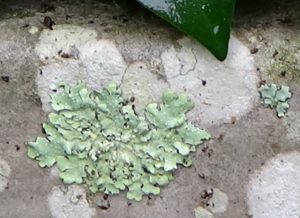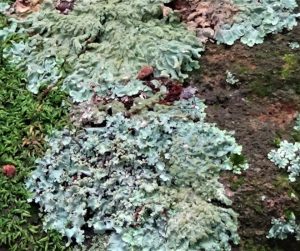
By Beverly Adams & Heather Kolich, Agriculture and Natural Resources Program, UGA Extension Forsyth County
We often get calls from concerned residents about a “fungus” growing on trees and killing them. Usually, the growth is lichen (pronounced like-in). While this example of nature’s creativity may be a sign of trouble with the tree, it is not the cause.
Lichens are the product of a mutually beneficial relationship between an ascomycete – the type of fungus that gives us yeast, truffles, and other edible mushrooms – and a green alga or cyanobacteria (blue-green algae). The fungus provides the structure that the slimy algae lacks, and the algae or cyanobacteria produce food to feed the fungus.
Lichens appear all over the earth, even in severe environments. Over 3,600 lichen species are known, by poetic names like sea-storm (Cetrelia chicitae) and hammered shield (Parmelia suclata), in North America. Lichens can grow on trees and rocks, tarps and cars, roof tiles and plastic storage bins – basically any surface that stays still long enough for the fungus to establish a foothold. On some surfaces, the attachment forms through a network of fungal filaments. On rocks, lichens usually attach at a single point.
The attachment of a lichen does not penetrate the surface of the substrate. Lichens are non-vascular; they don’t take water or nutrients from trees or other objects on which they grow. Instead, the algae photosynthesize to produce food for both organisms. The growth stimulated by the carbohydrates produced is a unique thallus, a vegetative offspring that doesn’t look like either of the parents.
Lichens occur in three growth forms: crustose, foliose, and fruticose. Crustose lichens look crusty – and indeed they form a crust over the substrate, whether it’s wood, rock, or even a stable sand dune. Some crustose lichens are colorful and look like they were painted on. About 75 percent of lichen species are the crustose growth form.

Foliose lichens are leaf-like in appearance and somewhat loosely attached to the substrate. Fruticose lichens are shrubby and may look like little beards hanging from twigs and tree branches.
Lichens are indicators of good air quality, and they provide vital ecological benefits that often go unnoticed. Lichens are a food source for caribou, moths, slugs, flying squirrels and other animals. They provide nesting materials for birds and a nitrogen source for plants. They are also ingredients in products such as dyes, deodorants, perfumes, and antibiotic salves.
So, what do lichens mean for trees? Lichens may be an indicator of poor plant health, but they are never the cause. On slow-growing and older trees, they are usually not a warning sign. On young, small trees that should be growing, however, lichens usually signal that the tree is under some type of environmental stress: moisture stress from wet or poorly draining soil, drought stress, nutrient stress, storm damage, cold damage, soil compaction, or a combination of these factors. While you can remove lichen by gently scraping it from the bark, it is not treatment for an ailing tree. Restoring the tree to health requires removing or mitigating stress factors.

For more information on lichens, visit the Lichens feature of the U.S. Forest Service website.